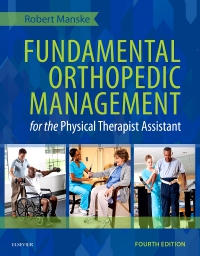
Fundamental Orthopedic Management for the Physical Therapist Assistant - Elsevier eBook on VitalSource, 4th Edition
Elsevier eBook on VitalSource

Now $56.69
Master the role and the skills of the physical therapist assistant! Fundamental Orthopedic Management for the Physical Therapist Assistant, 4th Edition helps you apply the principles of orthopedic science to physical therapy interventions. First you will learn how to assess flexibility, strength, endurance, and balance, and then you’ll become a more valuable PTA by learning the essentials of tissue healing, gait and manual therapy, biomechanics and kinesiology, and the management of orthopedic patients by region and condition. This edition includes a new full-color design and illustrations, and broadens its scope with new chapters on topics such as musculoskeletal imaging and women’s issues related to physical rehabilitation. Written by clinician and educator Robert Manske, along with a team of expert contributors, this text is your complete guide to success in physical therapist assisting!
Newer Edition Available
Fundamental Orthopedic Management for the Physical Therapist Assistant - Elsevier eBook on VitalSource
-
- Clear explanations of difficult concepts are provided by experienced, practicing clinicians who address the specific needs of the PTA.
- Comprehensive coverage provides a "one-stop" source for all things orthopedic, from core concepts related to orthopedics to information about the PTA's role in physical assessment and interventions, in-depth reviews of types of tissue healing, biomechanics, and pharmacology.
- A focus on critical thinking and application helps to prepare you for the treatment room and for the clinical practicum portions of the curriculum.
- Key terms and learning objectives begin each chapter, useful as "checkpoints" to which you can refer to ensure content comprehension and study effectively for examinations.
- Over 500 illustrations reinforce concepts and procedures, supplemented by summary tables and boxes.
- End-of-chapter review questions prepare you for the types of critical thinking you will be required to do in practice.
- Unique! End-of-chapter glossaries define key terms.
- Appendices provide a quick reference for information such as laboratory values, common medications, and associated movements.
- A six-part structure organizes the book's material:
- Part I: Basic Concepts of Orthopedic Management begins with the essential concepts of teamwork and shared responsibility within the physical therapy team and then covers the basic areas of flexibility, strength, endurance, balance, and coordination.
- Part II: Review of Tissue Healing introduces the types of tissue, then discusses ligament, bone, cartilage, muscle and tendon healing before looking briefly at neurovascular healing and thromboembolic disease.
- Part III: Common Medications in Orthopedics focuses on common medications used in orthopedics, their actions, side effects, and possible impact on treatment.
- Part IV: Mobilization and Biomechanics deals with the basics of human movement including a chapter on gait, and provides information on joint mobilization.
- Part V: Management of Orthopedic Conditions by Region covers the body from the ankle, foot, and toes up to the shoulder, the elbow, and the wrist and hand, including a chapter on the spine.
- NEW! Part VI: Management of Orthopedic Conditions by Affliction includes chapters on hot topics such as rheumatic disease; pain and pain-related syndromes; and bracing, orthotics, and prosthetics.
- Student resources on a companion Evolve website include critical thinking applications, review questions, animations, reference lists from the book linked to MedLine, and more.
-
- NEW Differential Diagnosis and Emergent Conditions chapter shows how similar symptoms can mask potentially dangerous pathologies and conditions, and may require re-evaluation by the supervising therapist.
- NEW Musculoskeletal Imaging chapter explains in basic terms the various types of musculoskeletal imaging used when examining musculoskeletal injuries.
- NEW Orthopedic Management Concepts Specific to Women chapter covers the issues, pathology, and progression of women’s health issues as they relate to physical rehabilitation.
- NEW! Full-color design and illustrations add clarity to anatomy and procedural drawings and make it easier to learn important concepts.
- NEW! Important Concepts highlight useful tips and tricks of patient practice.
- NEW student resources on the Evolve companion website include critical thinking applications, weblinks to related sites, and references with links to Medline® abstracts.
-
Part I: Basic Concepts of Orthopedic Management
1. Patient Supervision and Observation During Treatment
2. The Role of the Physical Therapist Assistant in Physical Assessment
3. Differential Diagnosis and Emergent Conditions NEW!
4. Muscle Flexibility and Range of Motion
5. Muscle Strength
6. Endurance
7. Balance and Coordination
Part II: Review of Tissue Healing
8. Composition and Function of Connective Tissue
9. Ligament Healing
10. Bone Healing
11. Cartilage Healing
12. Muscle and Tendon Healing
13. Neurovascular Healing and Thromboembolic Disease
Part III: Basis for Movement
14. Fundamentals of Normal and Abnormal Gait
15. Concepts of Joint and Soft Tissue Mobilization
16. Biomechanics and Kinesiology
Part V: Management of Orthopedic Patients by Region
17. Orthopedic Management of the Ankle, Foot, and Toes
18. Orthopedic Management of the Knee
19. Orthopedic Management of the Hip and Pelvis
20. Orthopedic Management of the Lumbar, Thoracic, and Cervical Spine
21. Orthopedic Management of the Shoulder
22. Orthopedic Management of the Elbow
23. Orthopedic Management of the Wrist and Hand
Part VI: Management of Orthopedic Patients by Condition
24. Orthopedic Management of Rheumatic Disorders
25. Orthopedic Management of Pain and Pain Syndromes
26. Orthopedic Management of Bracing, Orthotics, and Prosthetics
27. Orthopedic Management Concepts Specific to Women NEW!
Part VIII: Topics in Orthopedics
28. Concepts of Orthopedic Pharmacology
29. Musculoskeletal Imaging NEW!
Appendices
A: Commonly Used Medications in Musculoskeletal Medicine
B: Reference Ranges for Commonly Used Tests
C: Units of Measurement and Terminology for the Description of Exercise and Sport Performance
D: Fracture Eponyms
E: Major Movements of the Body and the Muscles Acting at the Joints Causing the Movement


 as described in our
as described in our 